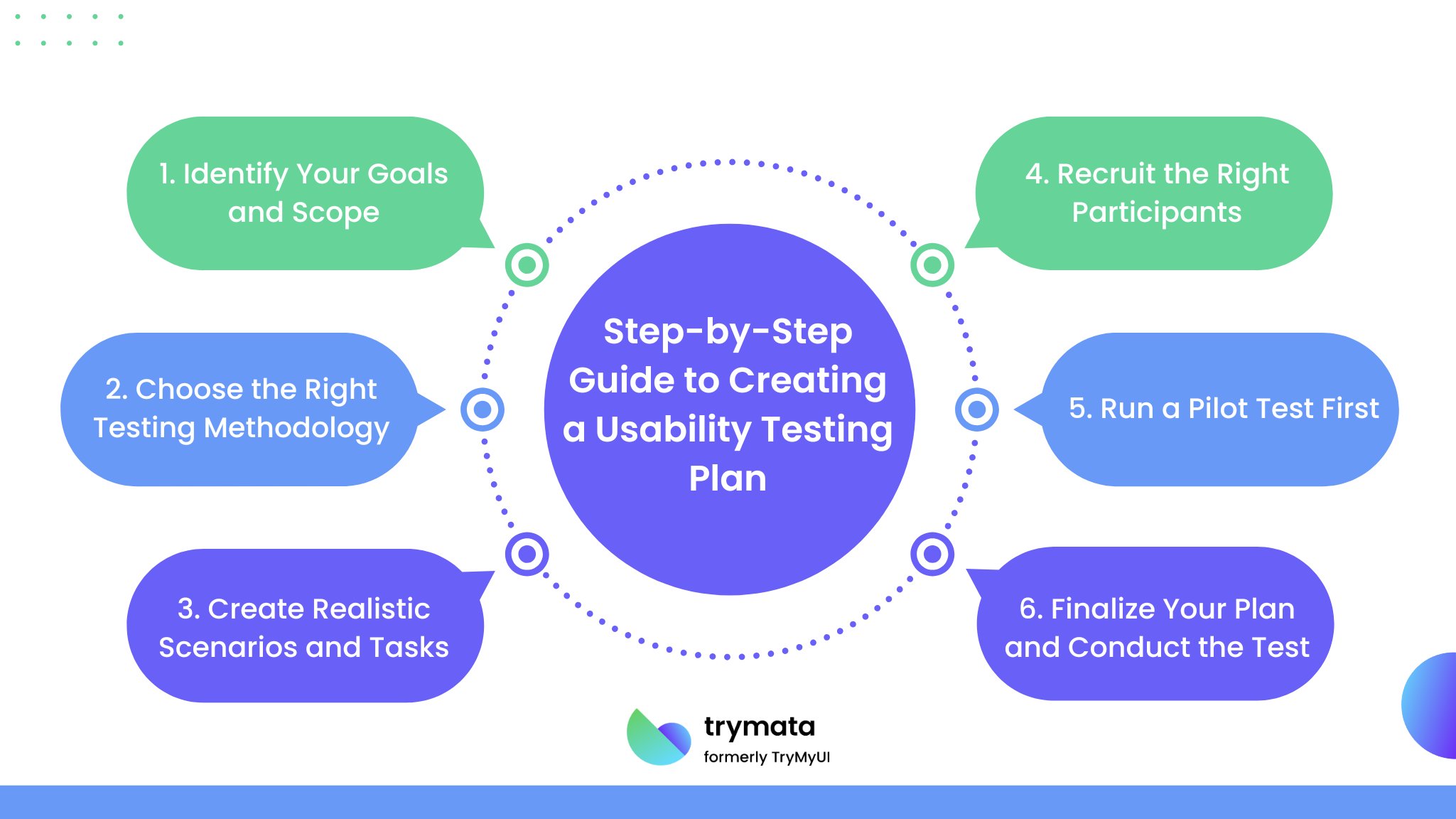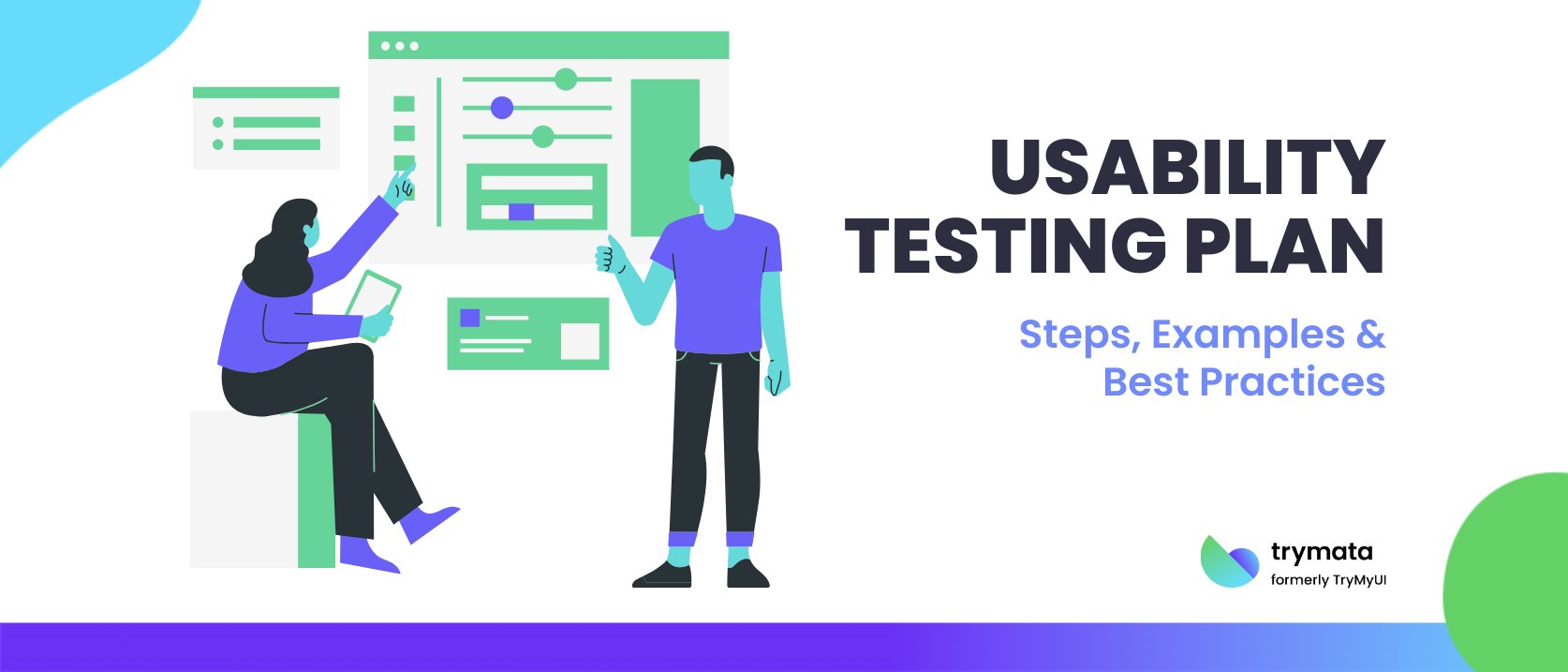If you’re serious about building products people love, you can’t just “wing” your usability tests. You need a usability testing plan and a step-by-step roadmap for running tests that give you clear, actionable insights instead of scattered, confusing feedback.
Think of it as your blueprint, as it lays out your goals, the scope, the methods, the tools you’ll use, and exactly how you’ll gather and analyze your data. The plan also helps you determine participant criteria, testing formats, and research goals to ensure your study is focused and effective. Without it, you risk wasting time, recruiting the wrong participants, or obtaining results that don’t move the needle for your UX.
With a solid plan, you’ll know what you want to learn, how to get the right data, and which users can give you the most relevant feedback, so that every test actually helps you improve your product. Defining goals at the outset is crucial, as it guides the entire usability testing process and ensures your research goals align with stakeholder needs.
What is a Usability Testing Plan?
If you want your usability testing to deliver real insights instead of random guesses, you need a usability testing plan, not a quick checklist. A test plan is a formal document that outlines the approach and structure for usability testing, ensuring every step is clearly defined.
Usability testing itself is all about watching how real users interact with your product. But a usability testing plan is about designing the test. These documents help organize scripts, notes, and reports for the testing process, making sure everything is documented and accessible.
You’ll choose the right scenarios, create meaningful tasks, select the perfect participants, and define your success metrics before the first click or tap happens.
Here’s why having a usability testing plan changes everything:
- You know exactly what you’re aiming for
No more “test and hope.” Everyone on your team understands the specific goals. - You use your resources wisely
From tools to participants, you’ll know what’s needed and avoid wasting time or budget. - Your data is clearer and more actionable
Structured planning reduces bias and ensures you don’t miss important patterns. - Your ROI skyrockets
Well-organized tests lead to product improvements that actually drive meaningful results. - Everyone stays aligned
Usability testing plans and related documents keep everyone on the same page throughout the process.
In short, your usability testing plan is the backbone of a smooth, efficient, and impactful testing process. Detailed plans and documents ensure nothing is overlooked during usability testing. Without it, you risk running a test that’s scattered, incomplete, and less likely to produce the results you need.
Why You Need a Usability Testing Plan
If you want your product to truly resonate with users, you need a usability testing plan. Without one, your tests can quickly spiral into disorganized sessions, inconsistent results, and missed opportunities to make meaningful improvements.
It guides your team, keeps you on track, and ensures that every minute spent testing is actually helping you build a better product. Here’s why it’s non-negotiable:
- It keeps your goals clear and focused
When you have a plan, you know exactly what you’re testing, which features matter most, and what tasks you want users to complete. This clarity stops you from getting lost in irrelevant details and keeps everyone working toward the same usability goals. - It saves time, money, and effort
Whether it’s budget, time, or team effort, a solid usability testing plan ensures you’re maximizing your resources. You’ll avoid wasted sessions and ensure participants, researchers, and stakeholders are all in sync. - It gives you consistent, reliable data
By defining your success metrics, task flows, and evaluation criteria upfront, you get data you can actually trust. That means fewer personal biases and more accurate comparisons between different test participants. - It helps you make smarter product decisions
With structured, actionable insights, your team can prioritize improvements based on hard evidence instead of hunches. Stakeholders will also have a clearer picture of what needs fixing and why. Securing stakeholder buy-in is essential for ensuring everyone supports and follows the usability testing plan, which leads to more effective and organized research initiatives.
A usability testing plan turns a basic test into a strategic process. Obtaining buy-in from stakeholders helps streamline communication and ensures the plan’s success. It’s the difference between gathering random feedback and unlocking insights that truly move your product forward and deliver a better user experience.
The Core Components of a Strong Usability Testing Plan
If you’re serious about improving your product’s user experience, a solid usability testing plan is your secret weapon. Before you dive in, here’s how to make sure you’ve covered all the essentials.
- Your Test Objectives & Goals: Why are you running this usability test?
- Research Questions: Questions will guide your test scenarios and help you gather meaningful insights.
- Target Users & Recruitment Criteria: Participants who reflect your actual users. Include participant recruitment strategies to recruit participants that match your target audience.
- Test Scenarios & Tasks: Scenarios that feel like real-life situations. Include a mix of usability tasks, specific tasks, defined tasks, exploratory tasks, and open-ended tasks. Write tasks that align with your usability study goals to ensure you gather actionable insights during your usability studies.
- Metrics & Success Criteria: Quantitative and qualitative metrics.
- Tools & Resources: Usability testing platforms like Trymata and in-person devices, as well as project management tools to organize your process. Use usability testing tools to test prototypes and prototypes during your usability studies.
- Checklists & Templates: Utilize usability testing templates, checklists, and a usability test plan dashboard to streamline planning, tracking, and documentation.
- Timeline & Logistics: Schedule for recruiting participants, running tests, and analyzing results.
- Best Practices: Focus on taking notes, observing participants, ensuring accessibility, and maintaining detailed documentation throughout the usability study process.
Step-by-Step Guide to Creating a Usability Testing Plan
To deliver real, actionable insights, your usability testing plan needs a structured, step-by-step approach.
Selecting the right method for your usability research is crucial, and you can integrate different tools and plans, such as templates and checklists, for a comprehensive and efficient process. When you follow a logical process, you’ll not only get accurate data but also make smarter design decisions that actually improve your user experience.
Here’s exactly how to create a usability testing plan that works.

1. Identify Your Goals and Scope
Start by asking yourself, What do I actually want to learn from this test?
Consider what you hope to achieve and how these objectives align with your overall research goals.
- Are you validating a new feature before launch?
- Trying to uncover navigation pain points?
- Comparing two design variations to see which works best?
Once your goal is crystal clear, define the scope:
- Which product areas you test.
- How many scenarios you include.
- How broad or narrow your focus should be.
This keeps you from falling into the trap of “testing everything at once” and ending up with watered-down results.
2. Choose the Right Testing Methodology
The right usability testing plan depends on choosing the approach that fits your goals, budget, and resources. User testing is a core method for evaluating website usability and gathering actionable feedback:
- Moderated testing: A facilitator guides participants in real time.
- Unmoderated testing: Participants complete tasks independently, often recorded using software.
- Remote usability testing: Conduct usability tests with participants in different locations using online tools.
- In-person testing: Best for observing body language, device handling, and in-context use.
Select the one that will provide you with the most relevant feedback for your objectives.
Best Usability Testing Methods: Types, Advantages & Examples
3. Create Realistic Scenarios and Tasks
Your test scenarios should feel like real-world use cases, not random assignments. For example:
Scenario:
You’ve just created an account and want to personalize your profile. In this task, you may need to find the settings or features required to update your profile.
Task:
Upload a profile picture and change your display name.
Keep your instructions neutral, don’t hint at the “right” answer. When you write tasks, make sure they accurately reflect user goals and behaviors to obtain valid insights. This ensures the feedback you collect reflects genuine user behavior.
4. Recruit the Right Participants
Your usability testing plan is only as good as the people you test with. Define your ideal participant profile:
- Demographics
- Experience level
- Familiarity with your product.
Effective participant recruitment strategies, such as using user interviews, can help you recruit participants who provide valuable feedback and ensure your test group matches your target audience.
Make sure your recruitment criteria align with your actual target audience to ensure the results are truly representative.
5. Run a Pilot Test First
Before you dive into the full study, do a small pilot test with 1–2 participants.
This will help you identify unclear instructions, technical issues, or unrealistic tasks early on, and it can save you time, money, and frustration later. If your pilot reveals unclear instructions or areas needing improvement, consider seeking more guidance to refine your usability testing process.
6. Finalize Your Plan and Conduct the Test
After your pilot, refine your usability testing plan. Confirm your tools, resources, and schedule, then run the test. When conducting the usability test, consider using dedicated usability testing tools to streamline the process and ensure accurate results.
Track both quantitative metrics (like completion times and success rates) and qualitative feedback (like frustrations and suggestions).
A strong usability testing plan enhances the reliability, repeatability, and impact of your findings. And if you use a dedicated usability testing platform like Trymata, creating a free account gives you access to advanced usability testing tools and features that make the entire process more efficient. And you can spend more time improving your product and less time wrestling with logistics.
Analyzing Usability Test Results
Analyzing usability test results is where the real value of your usability testing process comes to life. After your testing sessions are complete, it’s time to dig into the data and uncover the story behind your users’ actions. This step is all about transforming raw observations and feedback into actionable insights that can drive meaningful improvements in your product.
Start by reviewing all the data collected during your usability test, which includes screen recordings, notes, success rates, completion times, and any direct feedback from participants. Look for recurring patterns:
- Are multiple users struggling with the same task?
- Do certain steps consistently cause confusion or frustration?
Identifying these trends helps you pinpoint the most critical usability issues.
Next, organize your findings by grouping similar problems together. This makes it easier to see which issues are most widespread and which are isolated incidents. Prioritize the problems based on their impact on the user experience and your project goals.
Don’t forget to balance quantitative data with qualitative insights. Both types of data are essential for a well-rounded understanding of your usability test results.
Finally, turn your research findings into clear, actionable recommendations. For each issue you identify, suggest specific changes or next steps that will improve usability. Share these insights with your team so everyone is on the same page and ready to take action.
By following a structured approach to analyzing your usability testing results, you ensure that every testing session leads to real improvements, which makes your product more intuitive, efficient, and enjoyable for your users.
Mistakes to Avoid When Creating a Usability Testing Plan
Even if you’ve run usability tests before, creating an effective usability testing plan can still be tricky. Using detailed plans helps you avoid common pitfalls and ensures your usability testing is both efficient and actionable. Avoiding these common mistakes will help you save time, reduce costs, and get insights that truly matter.
- Overcomplicating Tasks
If your tasks are too long or complex, participants can get overwhelmed, and your results may become unreliable. Keep each task short, clear, and focused on a single objective. - Testing Without a Clear Hypothesis
Running a test without a hypothesis is like sailing without a destination. You’ll gather data, but it may not provide any useful insights. Start your usability testing plan with a clear goal, such as validating a new navigation layout or uncovering potential usability issues. - Recruiting the Wrong Participants
Your test results are only as good as the participants who take them. Testing with people outside your target audience can lead to misleading insights. Make sure your recruitment process aligns with your product’s demographics, experience level, and familiarity. - Skipping Pilot Runs
Pilot tests might seem optional, but they’re essential. They help you catch unclear instructions, technical glitches, or flaws in task design before you run the full study. Skipping this step could mean collecting unusable or flawed data in your usability testing plan. Having detailed plans at this stage is crucial to ensure your results are reliable and your usability testing process is thorough.
How Trymata Makes Your Usability Testing Plan Easier to Execute
Creating a usability testing plan is just the first step. With an all-in-one usability testing platform, you can take your plan from concept to actionable insights without the usual headaches.
Here’s how Trymata can make your usability testing plan more effective:
- Task Creation Made Simple: Design and assign realistic, goal-oriented tasks that reflect how real users interact with your product.
- Built-in User Recruitment: Instantly access a diverse panel of participants that match your target audience, saving you hours of recruitment work.
- Automated Session Recording: Capture screens, voice, and interactions so you can analyze user behavior in detail.
- Powerful Analytics: Combine qualitative insights with quantitative metrics like time-on-task, click paths, and success rates to make informed decisions.
- Usability Test Plan Management: Easily create, manage, and customize your usability test plan and test plan templates within Trymata, ensuring your testing sessions are structured and organized for maximum effectiveness.
Take this example:
A product team used Trymata to test a new onboarding process. By following a clear usability testing plan and leveraging Trymata’s features, they discovered a 40% drop-off on the first task. With quick design adjustments, they boosted onboarding completion rates by over 25% in the next release.
When you pair a strong usability testing plan with Trymata’s tools, you streamline your workflow, recruit the right participants, and uncover insights that drive measurable UX improvements, which can make your product more intuitive and user-friendly.
Conclusion
Creating a usability testing plan is your roadmap to understanding your users and making smarter product decisions. When you define clear objectives, design realistic tasks, and choose the right participants, you’re setting yourself up for insights that actually drive improvements instead of relying on guesswork.
By starting with a solid usability testing plan, you’ll save time, avoid costly mistakes, and make sure every session moves your product closer to what your users really need.
Are you ready to turn feedback into action? Build your usability testing plan with Trymata and start transforming user insights into real, measurable improvements for your product.




